The Intel Core i9-7980XE and Core i9-7960X CPU Review Part 1: Workstation
by Ian Cutress on September 25, 2017 3:01 AM ESTBenchmarking Performance: CPU System Tests
Our first set of tests is our general system tests. These set of tests are meant to emulate more about what people usually do on a system, like opening large files or processing small stacks of data. This is a bit different to our office testing, which uses more industry standard benchmarks, and a few of the benchmarks here are relatively new and different.
All of our benchmark results can also be found in our benchmark engine, Bench.
PDF Opening
First up is a self-penned test using a monstrous PDF we once received in advance of attending an event. While the PDF was only a single page, it had so many high-quality layers embedded it was taking north of 15 seconds to open and to gain control on the mid-range notebook I was using at the time. This put it as a great candidate for our 'let's open an obnoxious PDF' test. Here we use Adobe Reader DC, and disable all the update functionality within. The benchmark sets the screen to 1080p, opens the PDF to in fit-to-screen mode, and measures the time from sending the command to open the PDF until it is fully displayed and the user can take control of the software again. The test is repeated ten times, and the average time taken. Results are in milliseconds.
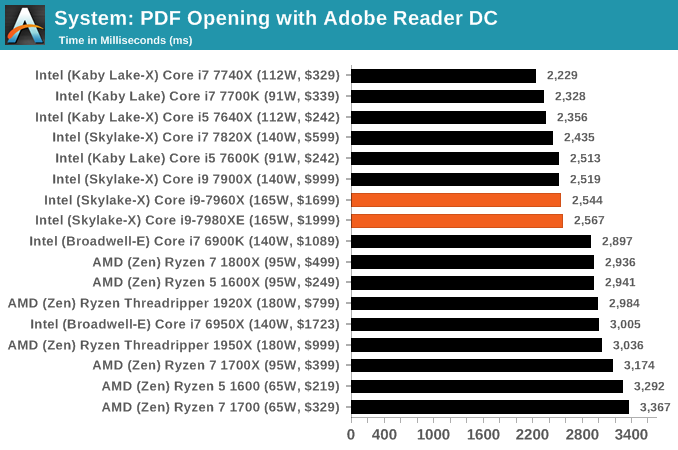
FCAT Processing: link
One of the more interesting workloads that has crossed our desks in recent quarters is FCAT - the tool we use to measure stuttering in gaming due to dropped or runt frames. The FCAT process requires enabling a color-based overlay onto a game, recording the gameplay, and then parsing the video file through the analysis software. The software is mostly single-threaded, however because the video is basically in a raw format, the file size is large and requires moving a lot of data around. For our test, we take a 90-second clip of the Rise of the Tomb Raider benchmark running on a GTX 980 Ti at 1440p, which comes in around 21 GB, and measure the time it takes to process through the visual analysis tool.
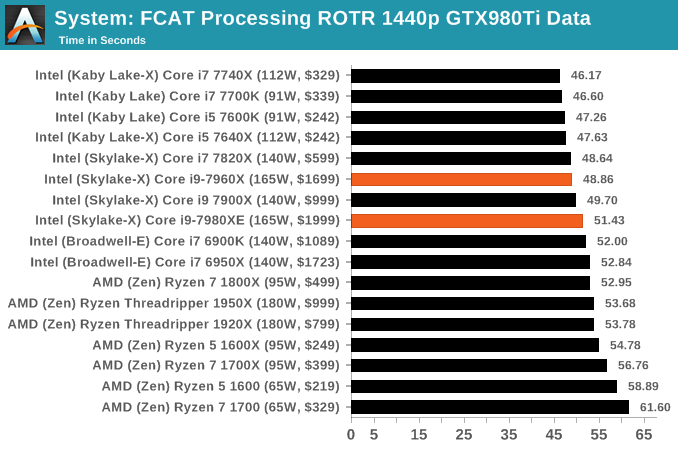
Dolphin Benchmark: link
Many emulators are often bound by single thread CPU performance, and general reports tended to suggest that Haswell provided a significant boost to emulator performance. This benchmark runs a Wii program that ray traces a complex 3D scene inside the Dolphin Wii emulator. Performance on this benchmark is a good proxy of the speed of Dolphin CPU emulation, which is an intensive single core task using most aspects of a CPU. Results are given in minutes, where the Wii itself scores 17.53 minutes.
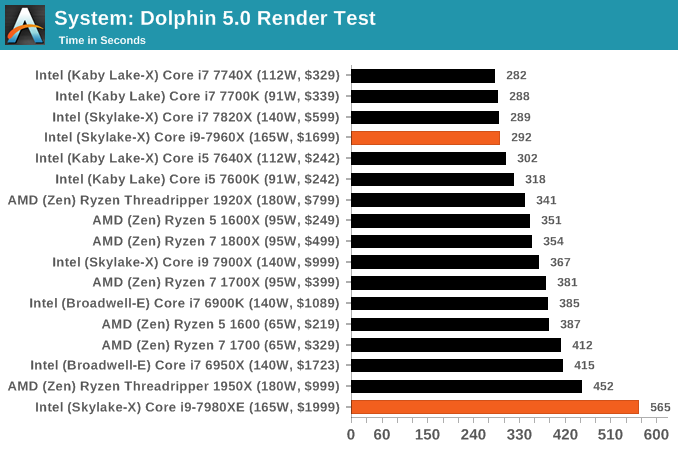
3D Movement Algorithm Test v2.1: link
This is the latest version of the self-penned 3DPM benchmark. The goal of 3DPM is to simulate semi-optimized scientific algorithms taken directly from my doctorate thesis. Version 2.1 improves over 2.0 by passing the main particle structs by reference rather than by value, and decreasing the amount of double->float->double recasts the compiler was adding in. It affords a ~25% speed-up over v2.0, which means new data.
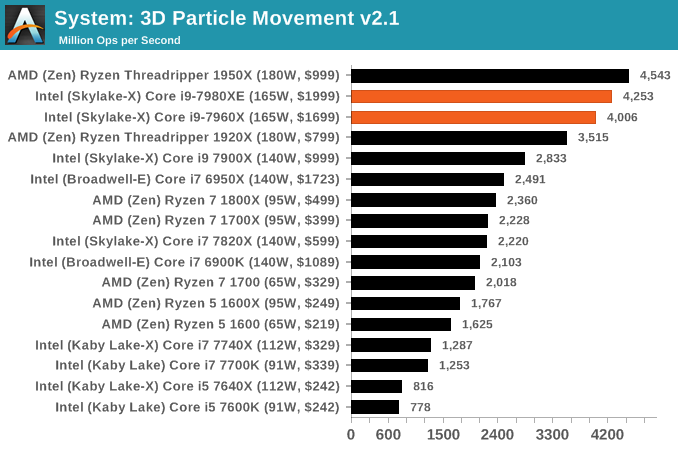
DigiCortex v1.20: link
Despite being a couple of years old, the DigiCortex software is a pet project for the visualization of neuron and synapse activity in the brain. The software comes with a variety of benchmark modes, and we take the small benchmark which runs a 32k neuron/1.8B synapse simulation. The results on the output are given as a fraction of whether the system can simulate in real-time, so anything above a value of one is suitable for real-time work. The benchmark offers a 'no firing synapse' mode, which in essence detects DRAM and bus speed, however we take the firing mode which adds CPU work with every firing.
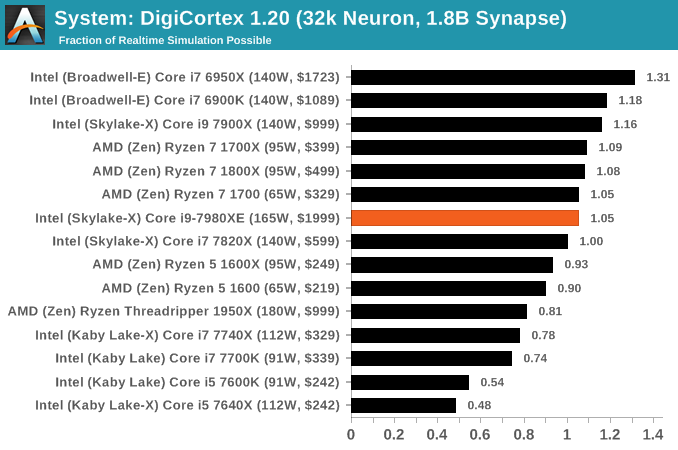
Agisoft Photoscan 1.3.3: link
Photoscan stays in our benchmark suite from the previous version, however now we are running on Windows 10 so features such as Speed Shift on the latest processors come into play. The concept of Photoscan is translating many 2D images into a 3D model - so the more detailed the images, and the more you have, the better the model. The algorithm has four stages, some single threaded and some multi-threaded, along with some cache/memory dependency in there as well. For some of the more variable threaded workload, features such as Speed Shift and XFR will be able to take advantage of CPU stalls or downtime, giving sizeable speedups on newer microarchitectures.
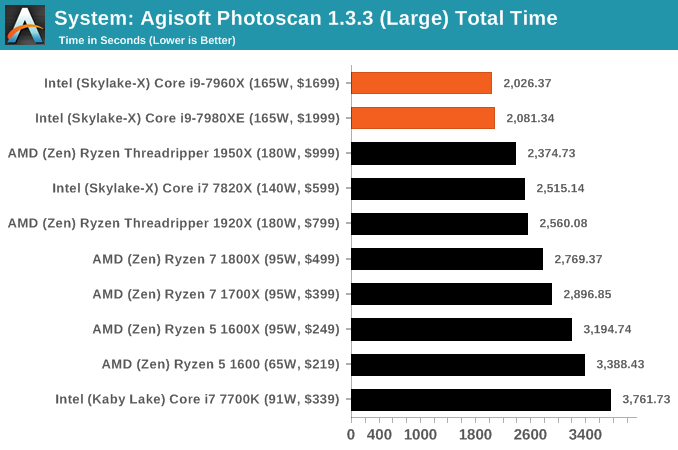










152 Comments
View All Comments
Notmyusualid - Tuesday, September 26, 2017 - link
@ vladxTry telling that to the fanbios here...
For some of us, price is not the main consideration.
HStewart - Monday, September 25, 2017 - link
I have a big issue with latest performance results - especially dealing with multi-core performance. What is most important is single core performance - this primary because real applications and not benchmark application use the primary thread more that secondary threads. Yes the secondary threads do help in calculations and such - but most important especially in graphical application is using the primary thread. Plus quality is important - I not sure AMD is going to last in this world - because they seem to have a very limited focus.HStewart - Monday, September 25, 2017 - link
Especially GeekBench - I don't trust it all - realistically can an ARM processor beat huge Xeon processor. Give me break - lets be realistic.Krysto - Monday, September 25, 2017 - link
Intel is failing hard at competing, if it can only release chips that cost twice as much as AMD's for only a slight improvement in performance.vladx - Tuesday, September 26, 2017 - link
On the contrary, these chips will sell very well since they aren't geared towards "prosumers" but big businesses where every minute wasted could mean thousands $$ lost.willis936 - Monday, September 25, 2017 - link
That performance ler dollar page is amazing. I could look at graphs like that comparing all types of compinents and configurations against different workloads all day.Judas_g0at - Monday, September 25, 2017 - link
I didn't see anything about temp and thermals. For 2k, does Intel give you crappy thermal compound, or solder?Spunjji - Monday, September 25, 2017 - link
Spoiler alert: I hope you like cleaning toothpaste off your $1999 CPU.shabby - Monday, September 25, 2017 - link
Lol platform pcie lanes, good one intel, how many does threadripper have in this case?DanNeely - Monday, September 25, 2017 - link
TR has 60 platform PCIe3 lanes, 68 total if you count the 8 half speed PCIe2 lanes on the x399 chipset.